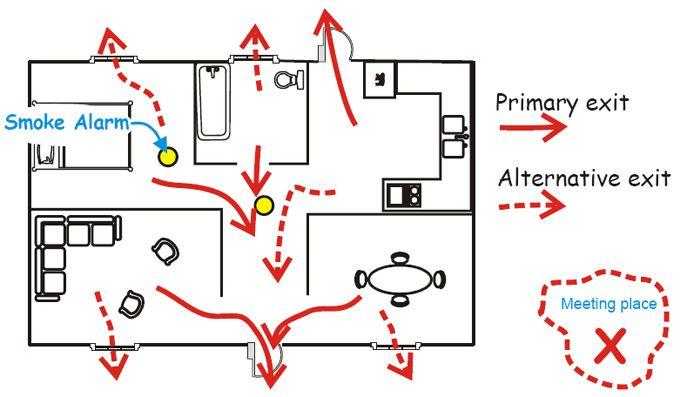Table of Contents
- Understanding the Importance of a Home Emergency Safety Plan
- Assessing Risks and Identifying Potential Hazards in Your Home
- Essential Emergency Supplies and Tools to Include in Your Plan
- Developing Clear Communication and Evacuation Procedures for Your Family
- Wrapping Up
Understanding the Importance of a Home Emergency Safety Plan
Having a well-structured emergency plan at home is more than just a precaution-it’s a crucial step in safeguarding your loved ones and property. Emergencies, whether natural disasters, fires, or sudden medical situations, can strike without warning. A thoughtfully designed plan ensures that everyone in the household knows exactly what to do, minimizing panic and confusion when every second counts. By preparing ahead of time, you equip yourself with the confidence and clarity needed to navigate stressful circumstances calmly and efficiently.
Incorporating essential elements into your safety plan, such as designated meeting points, emergency contact lists, and quick-access supply kits, greatly enhances your readiness. It’s equally important to regularly review and practice the plan with all family members, adapting it to any changes in your home or lifestyle. Remember, the true value of this plan lies in its ability to turn uncertainty into action, making a tangible difference when you need it most.
Assessing Risks and Identifying Potential Hazards in Your Home
Start by conducting a thorough walkthrough of every room in your home, paying close attention to areas where accidents are more likely to occur. Kitchens, bathrooms, stairways, and storage spaces often harbor hidden dangers such as slippery floors, exposed wiring, or unsecured heavy objects. Documenting these risks is crucial for developing preventative measures tailored to your specific living environment. Consider involving family members in this process to ensure no potential hazard is overlooked, and encourage open discussions to address concerns that may arise during the inspection.
When identifying threats, categorize them into immediate hazards and long-term risks. Immediate hazards might include things like overloaded power outlets or blocked emergency exits, while long-term risks could encompass structural issues or outdated smoke detectors. Don’t forget natural disaster vulnerabilities such as flood-prone areas or earthquake risks depending on your location. Creating an organized list with prioritization will help you focus on mitigating the most dangerous hazards first, making your home significantly safer in the face of emergencies.
Essential Emergency Supplies and Tools to Include in Your Plan
When assembling your emergency kit, focus on items that ensure survival, communication, and hygiene during unpredictable situations. Water tops the list – aim for at least one gallon per person per day, spanning a minimum of three days. Complement this with non-perishable, high-energy foods such as canned goods, protein bars, and dried fruits. Don’t forget a manual can opener and basic utensils. Flashlights with extra batteries or hand-crank lights offer essential illumination when power fails, while a battery-powered or crank radio keeps you informed about weather warnings and emergency updates. Additionally, include a first aid kit stocked with bandages, antiseptics, medications, and any prescribed drugs necessary for your family’s health.
Beyond the basics, incorporate tools and supplies that enhance safety and convenience. A multipurpose tool or sturdy pocket knife can be invaluable for quick repairs or food prep. Fire extinguishers, waterproof matches or lighters, and emergency blankets provide critical protection. Sanitation essentials like moist towelettes, garbage bags, and personal hygiene products play a vital role in maintaining health and comfort. Lastly, prepare backup power sources like portable chargers for mobile devices and ensure you have important documents sealed in waterproof containers. Crafting a kit tailored to your household’s unique needs fosters confidence and resilience when emergencies strike.
Developing Clear Communication and Evacuation Procedures for Your Family
Establishing effective communication channels is the backbone of any successful emergency plan. Start by deciding on a reliable method for everyone in your family to stay in touch, such as a group chat, prepaid phones, or walkie-talkies. It’s essential to designate an out-of-town contact who can act as a central point of communication if local networks become overloaded. Make sure every family member memorizes this contact’s number or has it saved in multiple accessible places. Additionally, agree on clear, simple codes or phrases to convey urgency without causing panic.
When it comes to evacuation, mapping out multiple escape routes from your home is crucial, considering every member’s unique needs and physical capabilities. Post clear, easy-to-read evacuation maps on each floor and conduct regular family drills to ensure everyone is familiar with the procedures. Designate safe meeting spots both within your neighborhood and outside your immediate area, so no matter the situation, your family knows exactly where to regroup. Preparation and repetition transform plans into instinct, increasing everyone’s safety and confidence during a real emergency.
- Choose and memorize an emergency contact outside your area
- Establish simple communication codes
- Map and practice multiple evacuation routes
- Designate indoor and outdoor family meeting points
- Hold regular communication and evacuation drills
Wrapping Up
Creating a comprehensive home emergency safety plan is an essential step toward protecting your loved ones and your property in times of crisis. By following the steps outlined in this guide, you can ensure that everyone in your household knows what to do, where to go, and how to stay safe when unexpected events occur. Remember, preparation is not just about having the right supplies-it’s about fostering clear communication, practicing your plan regularly, and staying informed. Take the time today to create or update your emergency plan; peace of mind is one of the greatest comforts when facing uncertainty. Stay safe and prepared!Check Our Other Blogs
- StunGun – Your Trusted Source for Stun Guns, Laws, and Self-Defense Tips
- PepperSprayLaws – Your Trusted Resource for Pepper Spray Information
- StunGunLaws – Your Trusted Guide to Stun Gun Legality and Safety



